Peacocks have long been admired for their resplendent plumage and regal demeanor. Few birds capture our imagination quite like the peacock. The vibrant colors of peacock feathers have enthralled generations of bird enthusiasts and nature lovers. From the iconic iridescent blues and greens to the striking hues of purple and bronze, the peacock’s majestic display never fails to mesmerize. However, rumors of a rare and elusive red peacock have sparked curiosity and debate among wildlife enthusiasts around the world.
So, let’s address the burning question: “Are red peacocks real?” Well, the answer is a resounding NO. To this day, there is no concrete evidence of the existence of red peacocks. While it’s true that peacocks come in a stunning array of colors, red is simply not one of them.
In this blog post, we embark on an exploration of the truth behind the existence of red peacocks. We delve into the scientific evidence, separate fact from fiction, and uncover the mysteries surrounding these captivating creatures. Join us as we venture into the realm of peacock lore, unveiling the secrets behind the stunning plumage and shedding light on the elusive nature of red peacocks.
Is there a Red Peacock?
There aren’t any red peacocks. Peacocks most often come in blue and green, although they may also be found in black, white, and purple. Peacocks have over 20 colors, but red is not one of them. You’ve probably seen edited photographs and videos of red peacocks online. The presence of red peacocks is not supported by any scientific data or sightings.
Color manipulation in video editing software may be used to generate videos of peacocks in different colors. It’s surprisingly simple to change the look of a peacock using digital manipulation.
Now, let’s speak about those enticing red peacock feathers that may be found in e-commerce sites or craft stores. It’s worth noting that these feathers are either colored or bleached copies of real blue or green feathers that have been skilfully converted into new colors. As a result, we cannot depend on them to provide convincing proof of the presence of red peacocks.
However, although there are presently no recorded examples, this does not rule out the possibility of seeing a true red peacock in the future. Scientists and researchers are constantly making new discoveries, discovering new species, encountering new kinds of existing species, and seeing the birth of new mutations through selective breeding. With these options in mind, it’s not completely out of the question. Who knows what the future will bring?
I hope this has piqued your interest in the many different colors that peacocks may display. Let’s take a deeper look at the intriguing world of peacock colors.
Understanding the Colors of Peacocks
What is the reason behind the peacock’s colorful appearance?
When it comes to brilliant colors, peacocks have a distinct advantage over other birds. Rather than solely relying on pigments, peacocks derive their colors from a combination of pigments and photonic crystals. The spacing between these crystals, as well as the angle of light that strikes the feathers, reflect different wavelengths of light. This phenomenon is responsible for peacocks’ stunning variety of colors, which resembles a mesmerizing rainbow.
Which are the most common peacock colors?
There are four colors that are more typically seen in peacocks than others:
- Iridescent tints of blue
- Yellow
- Green
- Brown
Iridescent Blue:
Certain peacock species have iridescent and bright blue colors on their head and neck, earning them the nickname “blue peacocks.” This blue color may also be detected in their feathers. The development of this color happens when photonic crystals build a network of 9 to 12 rods carrying melanin that are spaced 140 nanometers (nm) apart. These gems reflect blue light, giving them a stunning blue look.
Peacocks with blue eye markings on their tails are said to be among the healthiest.
Green Colour:
There are peacocks with green heads and necks. Both the blue and green peacock species have feathers that are mostly green in color. This color is created by photonic crystals organizing themselves into a square network of ten rods spaced 150 nm apart. When light interacts with this structure, the reflected wavelengths are in the green region of the spectrum.
Mellow Yellow Color:
There are no yellow-colored peacocks in the wild. Yellow, on the other hand, may be seen in certain areas or throughout the barbules (feather-like threads) of peacock feathers. The crystal network responsible for creating this color is made up of six rods spaced around 165 nm apart.
Brown and Copper:
Shades of brown and copper predominate on the tails and bodies of several peacock species. These colors may also have rare mutations, such as deep brown. The Buford Bronze species has a chocolate brown tail and dark brown eye patches. To create these colors, a rectangular crystal lattice with four rods spaced 150 to 185 nm apart is generated.
White Peacocks
White Peacocks are regarded as unusual and are often the consequence of mutations in the pigments of blue and green peacock species. These peacocks do not lack colors, but the pigments they create are coated in such a manner that they are undetectable. Leucism is a disorder that may be seen in a variety of animal species. As a result, the white peacocks seem mainly or entirely white. Female leucistic peacocks are born yellow and progressively become white as they age. There are also albino peacocks, which lack pigments or melanin, resulting in a completely white body with pink or crimson pupils.
Other Colors
In addition to the aforementioned colors, various colors have been recorded in peacocks, all of which are the result of genetic mutations in Indian peacocks. Violet, Cameo, Charcoal, Opal, Bronze, Peach, Midnight, Jade, Taupe, Sonja’s Violeta, Hazel, and Indigo are among the colors available. The majority of these colors may be seen in the peacock’s tail eyespots. All of these colors are recessive, which means that if peacocks of these colors mated with Indian peacocks, their young will be mostly blue, resembling Indian peacocks.
What is the rarest Peacock color?

Image Source
White is the most uncommon color seen in peacocks. As previously stated, the majority of white peacocks are the consequence of a genetic abnormality known as leucism in Indian peacocks, while some may suffer from albinism, which causes a loss of color. They are frequently considered the pinnacle of avian beauty due to their magnificent feathers and white bodies.
Now after reading about the colors of peacocks, I hope there won’t be any doubt left in your mind about Red Peacocks. If there is still doubt about the existence of Red Peacocks, continue reading as we have explained every single type of Peacock. It will further clear your mind about Red Peacoks
Species of peacocks
Indian Peafowl:
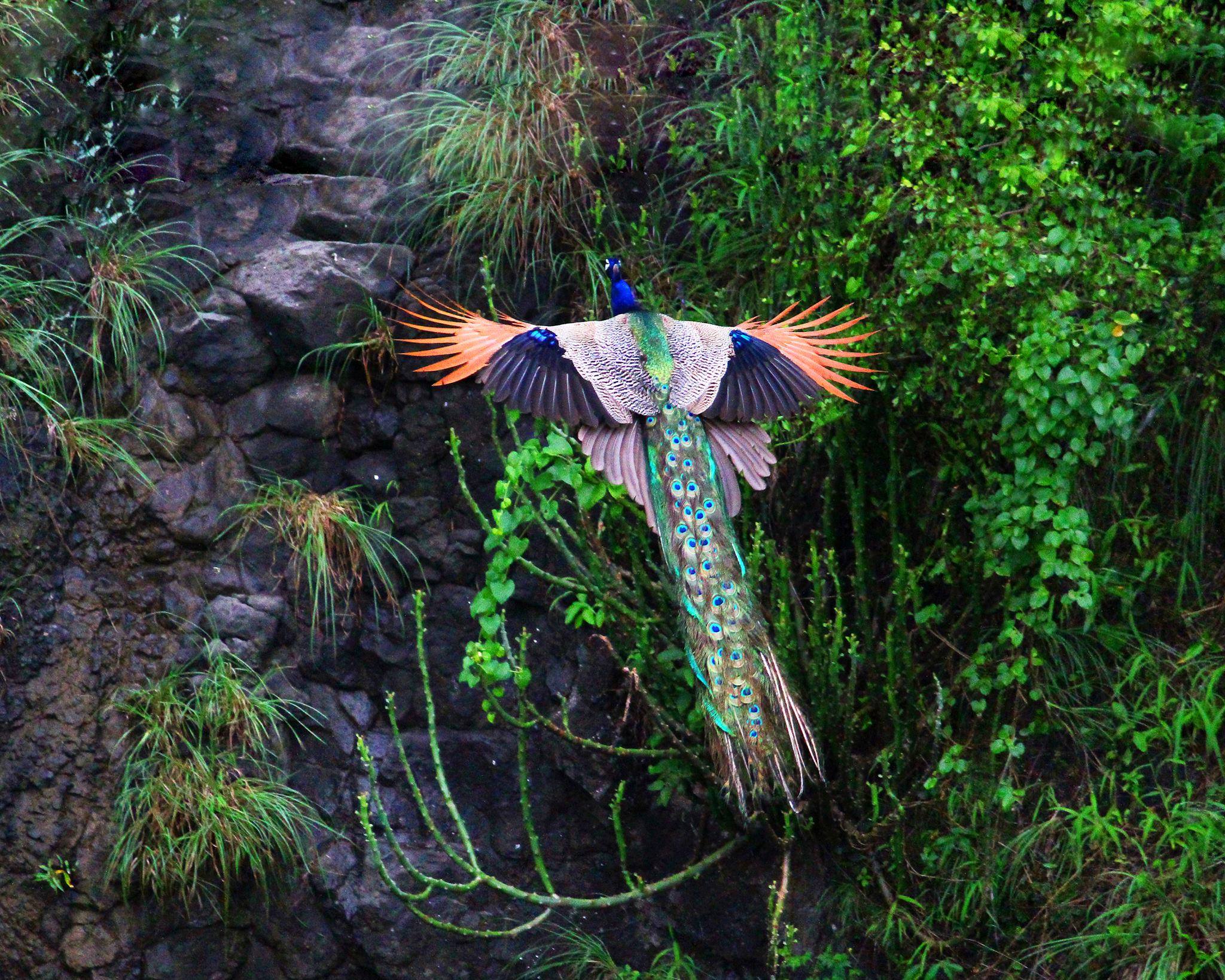
Image Source
- Scientific name: Pavo cristatus
- Lifespan: 15-20 years
- Size: 100-120 centimeters (39-47 inches)
- Origin: South Asia
Among the three primary kinds, the Indian peafowl is likely the most recognizable and popular. These birds, which are native to India, Sri Lanka, and other parts of Eastern Asia, have spectacular tail plumage as well as vivid blue heads and crests. During mating season, males exhibit their magnificent feathers in order to attract peahens. In India, these majestic birds are said to have “the feathers of an angel, the voice of the devil, and the walk of a thief.” While their remarkable appearance draws attention, their noisy cries may be very deafening, adding to their enigmatic attractiveness.
Green Peafowl

Image Source
The green peafowl, also known as the Javanese peafowl, is native to Southeast Asia, notably the Indonesian island of Java. They have vividly colored tail feathers and fan-shaped crests on their heads, similar to Indian peacocks. The green color of their heads and crests, as opposed to the blue of their Indian counterparts, distinguishes green peafowls. While the green peahens have some brightness, it is not as strong as that of the males. Green peafowls are quite quiet compared to other varieties, despite their flashy look. They are not only capable of long flights, but they are also the biggest of any peafowl species. Unfortunately, the green peafowl has been categorized as an endangered species since 2009 owing to habitat degradation.
Congo Peafowl

Image Source
Congo Peafowl is a remarkable bird species confined to Central Africa’s Congo Basin. It is related to the Indian Peafowl and the Green Peafowl, but it has distinct traits that set it apart from its cousins.
The Congo Peafowl is distinguished by its unique look. The male, often known as a peacock, has iridescent blue feathers on its head, neck, and breast. It has a unique head crest and long, beautiful tail feathers. The male Congo Peafowl, unlike the Indian Peafowl, lacks colorful eye-spotted train feathers but has elaborate patterns on its back.
The female, known as a peahen, has a more subdued look. She has brownish plumage with lighter markings, which allows her to blend in with her environment for safety and concealment. The female is in charge of constructing the nest and nurturing the eggs.
Congo Peafowls are mostly found in the Congo Basin’s deep jungles, where they graze on seeds, fruits, insects, and tiny invertebrates. They are ground birds that spend most of their time on the forest floor rather than in trees.
The survival of Congo Peafowls is threatened by a number of factors. The biggest threats are habitat loss due to deforestation and poaching for their flesh and feathers. Furthermore, since the Congo Peafowl has a narrow range, it is sensitive to population reductions.
Other variations of peacocks
These three varieties of peafowl demonstrate the fascinating variety of the peafowl family. However, a plethora of different peafowl varieties have evolved as a result of selective breeding by dedicated peafowl aficionados. Let’s look at some of the most well-known varieties:
Black-Shouldered Peafowl:
This Indian peafowl pattern mutation is distinguished by its dramatically black wings with a green/blue sheen. The recessive gene responsible for its distinct color distinguishes it from its Indian equivalent. Female black-shouldered peafowls have cream plumage with different tints and patterns.
Spalding Peafowl:
The Spalding peacock was created by crossing Indian and Java peafowls. Its color is similar to that of Java green. However, it has a longer, slimmer body and is larger than the Indian blue peafowl. When compared to its Indian cousin, the Spalding peahen has a brighter coloring, especially around the neck and head. The Spalding peafowl has spawned several variants, including the Spalding White, Spalding Pied, and Spalding Cameo.
White Peafowl:
Contrary to common perception, white peafowls are a color mutation originating from the Indian blue peafowl. Their white plumage is because of a pigment deficiency in their DNA. It is crucial to note, however, that this absence of pigmentation is restricted to their feathers and that they maintain color in their eyes. These magnificent birds were found in the wild in India and are proof of the fascinating variety of peafowl varieties.
The world of peafowls is a kaleidoscope of enchantment and unique creatures. Exploring these fascinating species increases our awareness of nature’s marvels and the enormous variety found within the bird realm.
Final Thoughts on Red Peacocks
After our deep exploration into the existence of red peacocks, we can confidently conclude that these captivating creatures do not exist in reality. While the peacock’s stunning array of colors encompasses a rich palette, red does not make the list.
Despite occasional claims and sightings of red peacocks, the lack of concrete scientific evidence leaves us with more questions than answers. It’s important to approach such claims with skepticism and evaluate them critically.
However, let us not be disheartened by the absence of red peacocks. Instead, let’s celebrate the extraordinary diversity of colors and patterns found within the Peafowl family. From the resplendent blues and greens to the enchanting whites and bronzes, each peacock is a testament to nature’s artistry.
As we conclude this journey, we invite you to embrace the magic and awe-inspiring beauty of peacocks, whether in their natural habitats, zoos, or even in artwork and literature. Let us continue to appreciate and protect these magnificent creatures, allowing them to grace our lives with their grace and elegance.
Further Readings
Frequently Asked Questions on Red Peacocks
Here are some frequently asked questions and answers on red peacocks
Are red peacocks a real species?
No, red peacocks are not a recognized or scientifically documented species. They belong to the realm of myth and folklore.
Can peacocks have red feathers?
While peacocks exhibit a wide range of vibrant colors, including blues, greens, and metallic tones, red is not a natural color found in their plumage.
Are there any videos or images of red peacocks?
Despite occasional claims and circulated videos or images, there is a lack of substantial evidence supporting the existence of red peacocks in the wild or captivity.
Why do some people claim to have seen red peacocks?
There could be several reasons behind such claims. Sometimes, misidentification of other bird species or alterations of images/videos can create the illusion of red peacocks. Additionally, artistic interpretations or selective breeding efforts might produce variations that resemble red feathers.
Can red peacock feathers be found for sale?
It is important to exercise caution when encountering vendors selling red peacock feathers. Genuine red peacock feathers are extremely rare and likely to be dyed or artificially altered. Authentic peacock feathers typically display the iconic blues, greens, and browns.
Are red peacocks a result of genetic mutations?
While genetic mutations can occur in various species, leading to different color variations, there is no scientific evidence supporting the existence of red peacocks resulting from natural genetic mutations.
Are red peacocks featured in ancient folklore or mythology?
Red peacocks have found their place in ancient legends, myths, and artistic representations across different cultures. Their inclusion in folklore highlights the enduring fascination and admiration for the peacock’s beauty and symbolism.
Are there any ongoing research efforts to study red peacocks?
As of now, there are no specific research projects focused on red peacocks. However, scientific studies continue to enhance our understanding of peafowl genetics, coloration, and behavior, shedding light on their natural variations.
What can we learn from the fascination with red peacocks?
The fascination with red peacocks reminds us of the enduring allure and wonder of nature. It encourages us to explore and appreciate the incredible diversity of the animal kingdom, while also acknowledging the power of imagination and cultural symbolism.
How can we support the conservation of peacocks and their habitats?
To support peacock conservation, we can contribute to initiatives that protect natural habitats, promote sustainable practices, and raise awareness about the importance of preserving biodiversity. Additionally, supporting reputable organizations dedicated to avian conservation can make a positive impact.

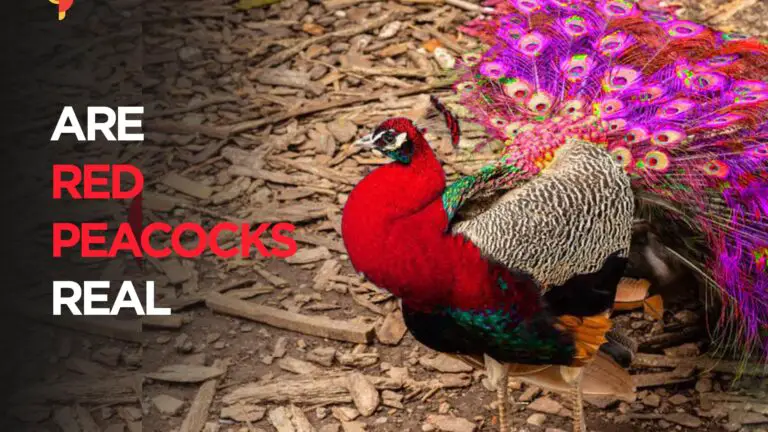
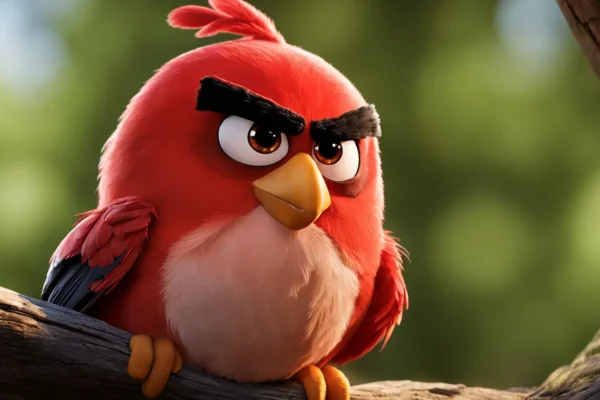
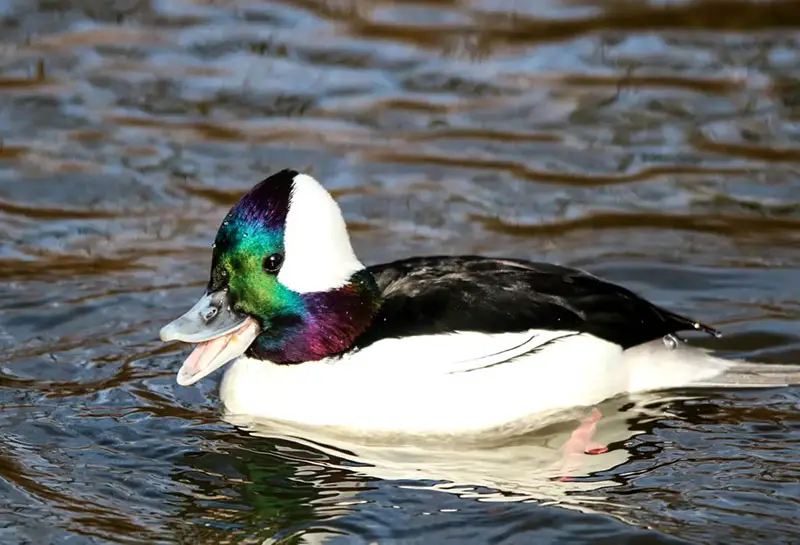
![Do Birds Eat Spiders? [All You Need to Know]](https://birdsology.com/wp-content/uploads/2023/05/43946482621_c9fd0edde9_b-600x400.jpg)
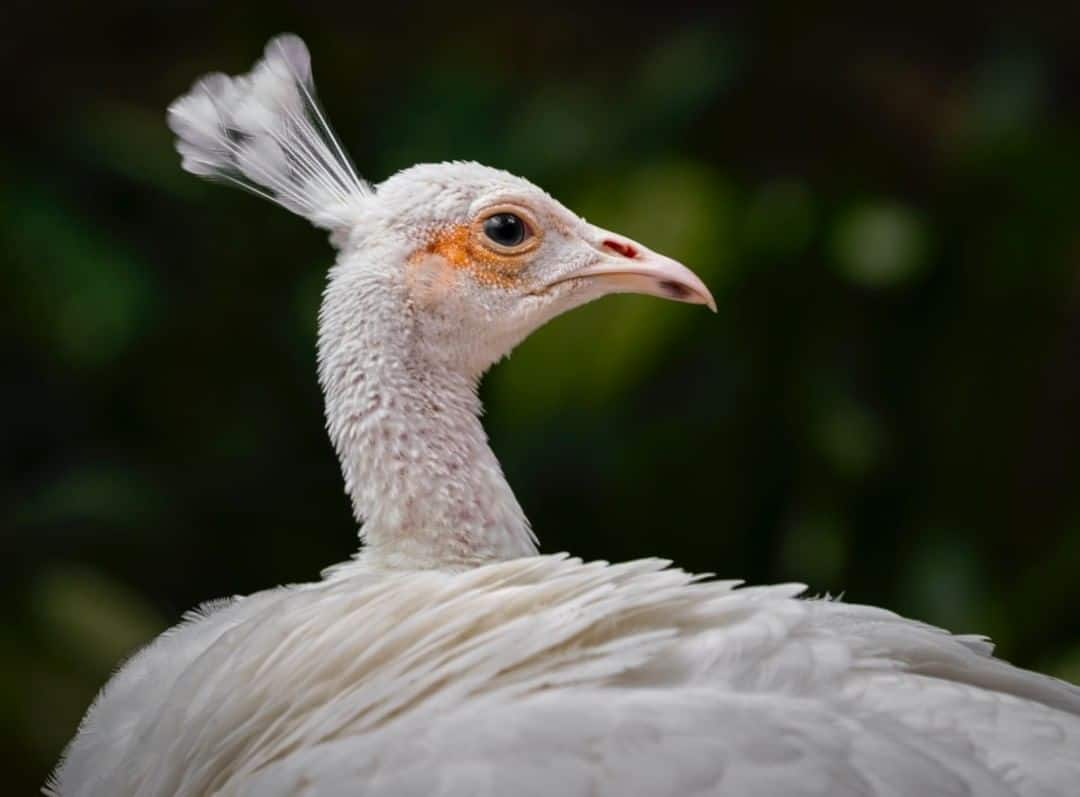
I am not real excellent with English but I get hold this really leisurely to understand.